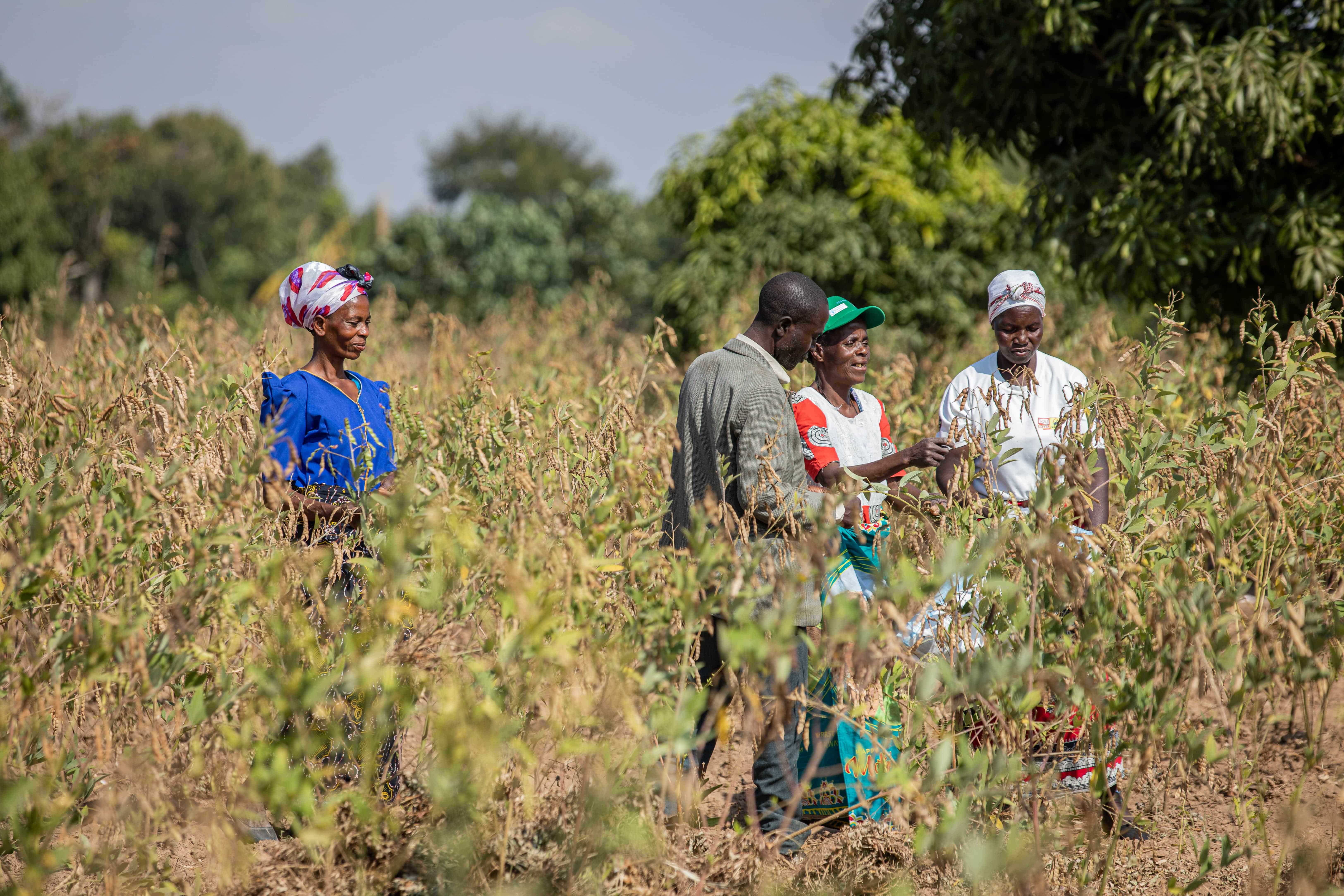
Shifting crops to adapt to changing climate conditions in Malawi
Edwin Kalengama’s switch from tobacco to pigeon pea and groundnut
Farmers are inspecting the pigeon pea crops they cultivate on a community field. In this field, they evaluate different lines of pigeon peas and groundnut. ©FAO/Emmanuel Manyamba
26/05/2023
Edwin Kalengama is a small-scale producer from Kasanda in the Mchinji District of Malawi. Traditionally, he had always grown tobacco on his small farm, but his yields began to fall off as rainfall declined and became increasingly unpredictable. His income also dropped and he noticed that growing tobacco was reducing the fertility of his land.
By chance, Edwin was walking past a nearby farmer’s field when he paused to look at some crops that were flourishing despite the drought that was affecting his own tobacco plants. He walked over to learn more from the group of farmers that had gathered and was inspecting the crops. The surprisingly healthy crops were pigeon pea and groundnut. In his own words,
Farming tobacco was not giving me benefits anymore, and worse, tobacco degrades the land. I switched to pigeon pea and groundnut because they provide a lot of benefits compared with tobacco. Also, pigeon pea crops are a source of firewood, relish and income. The leaves and roots improve soil structure and fertility, making the soil easier to work with.
A few years later, Edwin has become a local champion for pigeon pea and groundnut. He replaced his tobacco crop with intercropped pigeon pea and groundnut and his success had an immediate positive effect on his income. He also recognized that his land-use efficiency improved – much more yield and income could be generated from careful intercropping of pigeon pea and groundnut than was the case for a monocrop of tobacco. The income he generated from practising a new cropping system enabled him to buy goats and additional land.


Left/top: Biscuits, made from pigeon pea flour. Farmers exchange recipes in which they replace traditional ingredients such as maize and wheat for ingredients derived from groundnut and pigeon peas. ©FAO/Emmanuel Manyamba. Right/bottom: Pigeon pea in the Mchinji district in Malawi. The crop performs well despite the increasing droughts in the area. ©FAO/Emmanuel Manyamba
Edwin is now active in the local community seed reserve and teaches neighbouring communities about cultivation and consumption of pigeon pea and groundnut. Edwin’s experience serves as an example to other farmers in the region who must change their agricultural practices to adapt to frequent droughts and changing rainfall patterns. Edwin says,
Farmers implement what they learn from us trainers. We teach them about intercropping patterns, but also about recipes. For example, the lessons on making cakes from pigeon pea flour interest everyone. In difficult times, people sell pigeon pea cakes to earn extra money. Also, the training on farming practices helps us to manage our households better.

Edwin Kalengama is an advocate for groundnut and pigeon pea, crops that were relatively unknown to his area, but perform well despite increasing periods of droughts. He teaches his and other communities about cultivation and storage practices and shares recipes to use the crops in popular dishes. ©FAO/Isaac Zuze
Edwin’s farmers’ group and community seed reserve are supported by the Benefit-sharing Fund of the International Treaty on Plant Genetic Resources for Food and Agriculture at FAO and collaborate with researchers from ICRISAT, the International Crop Research Institute for the Semi-Arid Tropics, to evaluate and select varieties of pigeon pea and groundnut that best meet the needs and preferences of Malawi’s small-scale producers. Edwin says,
Our seed bank has helped a lot of households because people have access to seed that they use to cultivate, are able to meet food needs and also have proceeds from sales to buy livestock and iron sheets to roof their houses.
Edwin remains ambitious, saying that within five years he hopes,
We can buy a vehicle as a group, to rent out. We would also like to multiply more seeds and provide for more farmers, but also diversify into more crop varieties in addition to pigeon pea and groundnut so that should some team members run into difficulties, they will be able to get grain for food on loan from the group.
Edwin’s story is one of success, but situations can change quickly. Edwin and his neighbours have managed to adapt to changing climate, but their new crops will require careful management to ensure that debilitating pests and diseases are kept at bay. Also, the climate has not stopped changing and the change from tobacco to pigeon pea and groundnut is unlikely to be the last change that has to be made: a characteristic of farming has always been one of change and adaptation.
Video: A taste of Nyapwiri
Sarah Sikochi is a lead farmer in a community not far from Edwin's and she participates in the same project. Like Edwin, she started cultivating groundnut and pigeon peas and is testing which varieties serve her and her community best in terms of adaptation to the local context, for earning additional income, and for several cooking needs.
